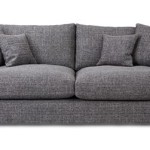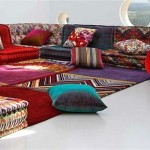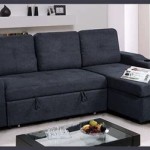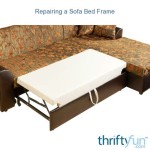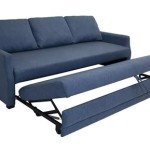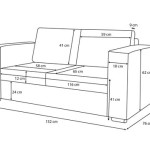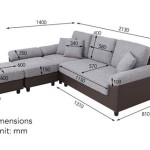Vintage Sectional Sofa: A Modern Perspective
The sectional sofa, a ubiquitous element of modern living rooms, enjoys a rich history that intersects with evolving trends in interior design. While often associated with contemporary aesthetics, the roots of the sectional can be traced back to earlier periods. Examining the "vintage sectional sofa" through a modern lens reveals a compelling story of adaptation, innovation, and enduring appeal. Understanding this evolution allows for a more informed appreciation of the sectional's current prominence and its potential future.
The term "vintage sectional sofa" typically refers to a sectional design originating from the mid-20th century, particularly the mid-century modern era. This period, spanning roughly from the 1940s to the 1960s, witnessed significant shifts in furniture design, characterized by clean lines, organic shapes, and the use of new materials. Sectional sofas from this era often featured low profiles, tapered legs, and upholstery in durable, patterned fabrics. However, sectional-like concepts existed before, though not always meeting the precise definition we hold today.
Today, the vintage sectional sofa is more than just a piece of furniture; it represents a tangible link to a design legacy. Its enduring popularity stems from its versatility, comfort, and potential to add character to contemporary spaces. Modern interpretations often incorporate elements of vintage design, blending historical aesthetics with contemporary needs. This fusion creates a unique aesthetic that appeals to those seeking both style and functionality.
The Evolution of the Sectional Concept
While the precise origin of the sectional sofa is debated, the concept of modular seating can be traced back to earlier forms of furniture. In the late 19th and early 20th centuries, parlor sets often included multiple seating pieces, such as sofas, armchairs, and settees, that could be arranged together. These pieces, though not explicitly designed as “sectionals,” demonstrated the desire for flexible seating arrangements. These sets often showcased elaborate detailing and ornate craftsmanship, reflecting the prevalent design sensibilities of the time.
The true sectional sofa, as we understand it today, began to emerge in the mid-20th century. Designers started experimenting with individual upholstered units that could be connected to form various configurations. This modularity was driven by several factors, including the rise of smaller living spaces, the growing preference for casual living, and the availability of new materials and manufacturing techniques. This period embraced functionality and clean aesthetics, a departure from the more ornate designs of the past.
Key design influences during this era included the Bauhaus movement and Scandinavian design principles. These movements emphasized simplicity, functionality, and the use of natural materials. Designers like Adrian Pearsall, Edward Wormley, and Milo Baughman created sectional sofas that exemplified these principles, often featuring sleek silhouettes, durable construction, and comfortable upholstery. These designers contributed significantly to the popularization and refinement of the sectional sofa concept.
The proliferation of mass production techniques further contributed to the sectional's accessibility. As manufacturing processes became more efficient, sectional sofas became more affordable and readily available to consumers. This accessibility, combined with its inherent versatility, cemented the sectional's status as a staple of modern living rooms.
Key Features of Vintage Sectional Sofas
Vintage sectional sofas typically exhibit several distinctive features that distinguish them from contemporary designs. These features reflect the design sensibilities and manufacturing techniques of the mid-20th century. Understanding these features is essential for identifying and appreciating the unique character of vintage sectionals.
One defining characteristic is the use of specific materials. Solid wood frames, often made from hardwoods like walnut or teak, provided structural integrity and aesthetic appeal. Upholstery materials commonly included durable fabrics like tweed, wool, or vinyl, often featuring geometric patterns or solid colors. The choice of these materials reflected the emphasis on longevity and practicality that characterized mid-century modern design.
Another key feature is the overall design aesthetic. Vintage sectionals typically have a low profile, with clean lines and simple shapes. Tapered legs, often made of wood or metal, are a common design element. The overall effect is one of understated elegance and functional design. The emphasis on clean lines and minimal ornamentation contributes to the timeless appeal of vintage sectionals.
The modularity of vintage sectionals also deserves attention. Individual units could be arranged in various configurations to suit different spaces and needs. This flexibility was a key selling point and contributed to the sectional's popularity. Common configurations included L-shaped sofas, U-shaped sofas, and even straight sofas with attached ottomans.
Finally, the quality of craftsmanship is a hallmark of vintage sectional sofas. These pieces were often made by skilled artisans using traditional techniques. This attention to detail resulted in furniture that was not only aesthetically pleasing but also durable and long-lasting. The high quality of craftsmanship is a testament to the value placed on skilled labor and enduring design during the mid-20th century.
Modern Interpretations and the Enduring Appeal
While vintage sectional sofas offer a tangible connection to the past, modern interpretations often incorporate elements of vintage design while addressing contemporary needs. This fusion of historical aesthetics and modern functionality has contributed to the sectional's enduring appeal.
Many contemporary designers draw inspiration from the clean lines and simple shapes of vintage sectionals. They may incorporate similar materials, such as solid wood frames and durable fabrics, while updating the color palettes and patterns to reflect current trends. This approach allows for the creation of furniture that is both stylish and respectful of its design heritage.
Modern sectionals also benefit from advancements in manufacturing techniques and materials. New types of foam and cushioning provide enhanced comfort, while innovative frame construction methods improve durability. These advancements ensure that modern sectionals are not only aesthetically pleasing but also comfortable and long-lasting.
The modularity of sectionals continues to be a key selling point. Modern designs often offer even greater flexibility, with individual units that can be easily reconfigured to suit different spaces and needs. This adaptability makes the sectional an ideal choice for contemporary living rooms, which often serve multiple functions.
The enduring appeal of the vintage sectional sofa, and its modern reinterpretations, lies in its ability to combine style, comfort, and functionality. Whether it's an original mid-century modern piece or a contemporary design inspired by the past, the sectional continues to be a versatile and stylish addition to modern homes. Its historical significance and ongoing relevance ensure that it will remain a staple of interior design for years to come. The integration of smart technologies into modern sectionals, like built-in charging ports and adjustable headrests, further enhances their appeal in our increasingly connected world. The focus on sustainable materials and ethical manufacturing practices also aligns modern sectionals with contemporary values, ensuring their continued relevance and desirability.

Custom Mid Century Sunrise 1960 S 3pc Sectional Sofa Fully Rehabbed

Kevinplus Modern Vintage Velvet Upholstered Sectional Sofa With Curved Design Large Seating For Living Rooms And Home Offices Left Chaise

3 Piece Retro Sectional Sofa Mcm Sofas Sectionals Loveseats For Sweet Modern Akron Oh

Custom Mid Century 1950 S Rainbow Pink Wool Plaid Sectional Fully Rehabbed

4 Piece Retro Sectional Sofa Mcm Sofas Sectionals Loveseats For Sweet Modern Akron Oh

9 S Curved Back Sectionals In Midcentury Modern Style Retro Renovation

Custom Mid Century Sunrise 1960 S 3pc Sectional Sofa Fully Rehabbed

Monroe 3pc Sectional Sofa Leg Finish Pecan Configuration Raf Chaise On The Right

Vintage Mid Century Modern Sectional Selig

Mid Century Modern Three Piece Sectional Sofa With Vintage White Upholstery Chairish

